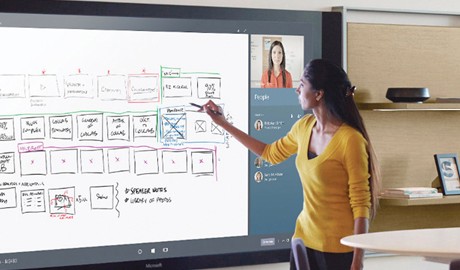Modern cloud workplaces
Ten success factors for change management
More and more companies want to take advantage of modern workplaces in the cloud. But how do you manage a change of this magnitude? Swisscom’s experience shows that the following 10 factors are key for the success of change management.
Text: Jörg Rothweiler, 20 june 2019
The digitisation of the world of work offers numerous advantages – but like every major change, it also poses challenges. This places particular demands on people. However, since these are much more difficult to find a “common denominator” for than office environments, devices or applications, much more is required for efficient change management than simply the installation of new tools. Instead, it is important to show employees why Work Smart is the future, what advantages it brings them and – above all – how “smart” working functions in the first place.
Accordingly, the transition to modern workstations from the hybrid cloud consists of several phases.
If you consider the following ten success factors for change management, not only can you successfully initiate this “cascade of change”, but above all roll it out to the end – and thus also safely lead large-scale and radical change projects such as the switch to cloud workstations to success.
1. Raising awareness
First of all you need to raise awareness, i.e. explain “why”. Set out the reasons for the impending change in order to raise awareness of its necessity. If you succeed in this, your employees will recognise the sense of the whole thing, and will be able to develop their own readiness for the desired change.
2. Defining the basis
Generate clarity with respect to the technology, infrastructure and architecture of the cloud before you get started. Bear in mind that IT is above all a means to an end. It is very important and by no means trivial, but the change in people’s mindsets that is essential for change requires considerably more attention and energy.
3. Effective and impactful communication
Raising the necessary awareness and engendering the motivation to want to become part of the change (desire), requires high-quality and penetrating communication, active community management, and for managers to act as role models and motivators. Never forget that persuasion must have a strong impact – and truly reach everyone. Otherwise it won’t work.
4. Getting the executive floor on board
The greater the change, the more support is required from management. Radical change processes must be supported “top down”. To this end, management must actively support the desired goals on the one hand and actively pre-examine the “new” itself on the other. Show understanding for those who may be slower, and leave no one behind on the long path of change.
5. Stay realistic
A concrete vision is important, but having the correct vision is essential. You should therefore clearly formulate what the planned change is intended to achieve, but also what it actually can achieve – and what it can’t. Realists with clear ideas are much more likely to achieve their goals than Utopians or idealistic dreamers.
6. Step by Step
Comprehensive change projects are implemented in phases. It is important and right to pause, look back, reflect and analyse at times. This enables you to draw the right conclusions and set the course for the next steps based on facts. You should therefore only migrate a small group at first, and remove any obstacles that come to light. Then involve a larger group, and reflect, analyse and optimise again. Only when you have identified all of the stumbling blocks and removed them do you finally complete the company-wide migration.
7. Empower employees
Enabling is essential for success. You must provide all employees with information, instruction and tailored training for the new tools. Those who don’t know modern work methods will be left behind, frustrated, resist change and block development. But those who have mastered the new working methods and their tools drive change forwards. The more such “accelerators” you have, the better.
8. Putting people at the centre
Always place the users (i.e. the employees) at the centre of your considerations. You must communicate the new tools and the changed way of working to individuals in such a way that they benefit as quickly as possible. This benefit fuels acceptance of the new, and drives the adoption rate upwards. It is important to consider the individual needs and challenges of teams and business units.
9. Think and act critically and openly
Every change has its stumbling blocks and sometimes holds surprises in store. It is therefore essential to honestly address and openly discuss problems – both internally and vis-à-vis partners. With hybrid cloud solutions, the operator of the public cloud solution does not do everything. The user also bears responsibility. Both should be prepared for problems that can only be solved together. Clear contact persons should therefore be designated on both sides, and an escalation map should be defined that offers guidance in the event of problems or crises.
10. Be patient and don’t give up
Patience and stamina guarantee success. Once the migration has been completed, the optimisation work begins. Continuous monitoring helps in this regard. This tells you how high the adoption rate is in the various different parts of the company, how intensively and in what form teams are using the new tools and methods, and where there are still challenges. In this way, you identify weaknesses and challenges, allowing you to evaluate them in a targeted manner and remedy them in the long term. Constant improvement allows you to continuously improve the benefit for users, and in so doing foster acceptance and motivation throughout the company. Your aim should therefore not be to achieve your goal. Your aim should be to keep improving.

Newsletter
Would you like to regularly receive interesting articles and whitepapers on current ICT topics?
More on the topic


